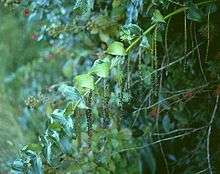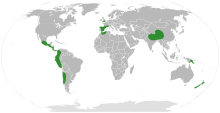Coriaria
| Coriaria | |
|---|---|
 | |
| Coriaria ruscifolia | |
| Scientific classification | |
| Kingdom: | Plantae |
| (unranked): | Angiosperms |
| (unranked): | Eudicots |
| (unranked): | Rosids |
| Order: | Cucurbitales |
| Family: | Coriariaceae Mirb.[1] |
| Genus: | Coriaria L. |
| Type species | |
| Coriaria myrtifolia L.[2][3] | |
 | |
| Coriaria distribution | |
| Synonyms[4] | |
| |
Coriaria is the sole genus in the family Coriariaceae described by Linnaeus in 1753.[3][5] It includes 14 species[6] of subshrubs, shrubs and small trees, with a widespread but disjunct distribution across warm temperate regions of the world, occurring as far apart as the Mediterranean region, southern and eastern Asia, New Zealand (where some are alpine species), the Pacific Ocean islands, and Central and South America.[4][7][8]
The leaves are opposite or in whorls, simple, 2–9 cm long, without stipules. The flowers are borne in racemes 2–30 cm long, each flower small, greenish, with five small petals. The fruit is a small and shiny black (occasionally yellow or red) berry-like swollen corolla, highly poisonous in several species, though those of C. terminalis are edible. At least a few members of this genus are non-legume nitrogen fixers.
The Mediterranean species C. myrtifolia is known as Redoul, and the several New Zealand species are known by the Māori name of tutu.
The South American species C. ruscifolia is an evergreen climber known as Deu or Huique, and its fruits are used in Southern Chile to make rat poison.
- Species[4]
- Coriaria angustissima - New Zealand (South I + Stewart I)
- Coriaria arborea - New Zealand (South I, North I, Chatham Is, Kermadec Is)
- Coriaria duthiei - W Himalayas (N Pakistan + Kashmir, N India)
- Coriaria japonica - Japan, Taiwan
- Coriaria kingiana - New Zealand North I
- Coriaria kweichovensis - S China, Himalayas
- Coriaria lurida - New Zealand (South I, North I)
- Coriaria myrtifolia - Spain, France, Italy, Algeria, Morocco, Greece, Tunisia[9]
- Coriaria napalensis - Himalayas
- Coriaria plumosa - New Zealand (South I, North I)
- Coriaria pottsiana - New Zealand North I
- Coriaria pteridoides - New Zealand North I
- Coriaria ruscifolia - Latin America from C Mexico to S Argentina + S Chile; New Guinea, New Zealand, islands of S Pacific
- Coriaria × sarlurida - New Zealand
- Coriaria × sarmangusta - New Zealand
- Coriaria terminalis - Sichuan, Tibet, Nepal, Sikkim, Bhutan
References
- ↑ Angiosperm Phylogeny Group (2009). "An update of the Angiosperm Phylogeny Group classification for the orders and families of flowering plants: APG III" (PDF). Botanical Journal of the Linnean Society. 161 (2): 105–121. doi:10.1111/j.1095-8339.2009.00996.x. Retrieved 2013-06-26.
- ↑ lectotype designated by M. L. Green, Prop. Brit. Bot. 192 (1929)
- 1 2 Tropicos, Coriaria L.
- 1 2 3 Kew World Checklist of Selected Plant Families
- ↑ Linnaeus, Carl von. 1753. Species Plantarum 2: 1037 in Latin
- ↑ Christenhusz, M. J. M. & Byng, J. W. (2016). "The number of known plants species in the world and its annual increase". Phytotaxa. Magnolia Press. 261 (3): 201–217. doi:10.11646/phytotaxa.261.3.1.
- ↑ Davidse, G., M. Sousa Sánchez, S. Knapp & F. Chiang Cabrera. 2014. Saururaceae a Zygophyllaceae. 2(3): ined. In G. Davidse, M. Sousa Sánchez, S. Knapp & F. Chiang Cabrera (eds.) Flora Mesoamericana. Universidad Nacional Autónoma de México, México
- ↑ Flora of China Vol. 11 Page 333 马桑科 ma sang ke Coriariaceae
- ↑ Altervista Flora Italiana, Sommacco a foglie di mirto, Tanner's Sumac, Coriaria myrtifolia L. includes photos and European distribution map